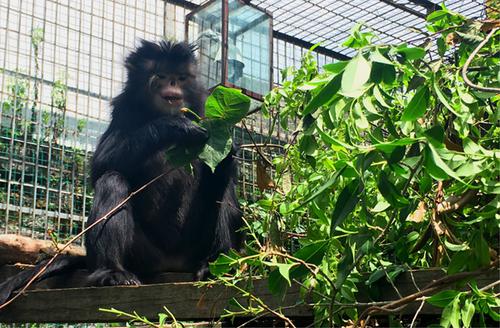当前位置:
X-MOL 学术
›
Am. J. Primatol.
›
论文详情
Our official English website, www.x-mol.net, welcomes your
feedback! (Note: you will need to create a separate account there.)
Cafeteria-style feeding trials provide new insights into the diet and nutritional strategies of the black snub-nosed monkey (Rhinopithecus strykeri): Implications for conservation.
American Journal of Primatology ( IF 2.0 ) Pub Date : 2020-02-25 , DOI: 10.1002/ajp.23108 Yin Yang 1, 2, 3 , Qihua Li 4 , Paul A Garber 5 , Cyril C Grueter 6, 7 , Guopeng Ren 1, 3 , Xinwen Wang 8 , Zhipang Huang 1, 3 , Zuofu Xiang 9 , Wen Xiao 1, 3 , Alison Behie 2
American Journal of Primatology ( IF 2.0 ) Pub Date : 2020-02-25 , DOI: 10.1002/ajp.23108 Yin Yang 1, 2, 3 , Qihua Li 4 , Paul A Garber 5 , Cyril C Grueter 6, 7 , Guopeng Ren 1, 3 , Xinwen Wang 8 , Zhipang Huang 1, 3 , Zuofu Xiang 9 , Wen Xiao 1, 3 , Alison Behie 2
Affiliation

|
Anthropogenic changes and fragmentation of natural habitats often exert a negative effect on resource availability and distribution, and the nutritional ecology and feeding behavior of nonhuman primates. The goals of this study are to examine food choice and to identify the nutritional profile of foods consumed by the Critically Endangered black snub-nosed monkey (Rhinopithecus strykeri). To accomplish our study goals, we presented cafeteria-style feeding trials of fresh food items collected in the home range of wild black snub-nosed monkeys to the only two captive R. strykeri, and compared the nutritional profiles of the leafy foods (buds, young, and mature leaves, 100 i23tems from 70 plant species) selected with those avoided (54 items from 48 plant species). Overall, the results indicate that captive R. strykeri selected foods that were higher in moisture (Mo; 77.7%), crude protein (CP; 21.2%), total nonstructural carbohydrates (TNC; 34.9%), and phosphorus (P; 0.37%) while tending to avoid foods with a neutral detergent fiber (NDF) content of greater than 46.8%. Leaves collected in autumn and selected by the monkeys were characterized by a slightly higher amount of metabolizable energy (ME) than those rejected (1,350 kJ/100 g vs. 1,268 kJ/100 g). In contrast, the protein content of foods collected and consumed during the spring was greater (22.9%) than in autumn (16.4%). Random Forests modeling, an ensemble learning method, indicated that the proportion of Mo, NDF, ME, CP, P, and TNC were among the most important factors in predicting which items were consumed by the captive R. strykeri during spring and autumn. On the basis of the nutritional profile of foods consumed across the two seasons, we identified 18 nutrient-rich native plant species that we recommend for use in ex- and in-situ conservation management and reforestation programs to provide long-term access to a nutritionally adequate diet.
中文翻译:

自助餐厅式喂养试验为黑鼻猴(Rhinopithecus strykeri)的饮食和营养策略提供了新见解:对保护的意义。
人为改变和自然栖息地的破碎往往对资源的可获得性和分布以及非人类灵长类动物的营养生态学和摄食行为产生负面影响。这项研究的目的是检查食物的选择并确定极度濒危的黑金丝猴(Rhinopithecus strykeri)食用的食物的营养成分。为了实现我们的研究目标,我们向仅两只圈养的史氏y猴(R. strykeri)展示了从野生黑金丝猴的家中采集的新鲜食物的自助餐厅式喂养试验,并比较了多叶食物的营养成分(预算,幼叶和成熟叶,从70种植物中选出100种i23tem,从中避免使用(48种植物中的54种)。总体而言,结果表明俘获了R。鹤望兰(Strykeri)选择了水分较高(Mo; 77.7%),粗蛋白(CP; 21.2%),总非结构性碳水化合物(TNC; 34.9%)和磷(P; 0.37%)较高的食物,同时倾向于避免食用中性食物洗涤剂纤维(NDF)含量大于46.8%。秋季收集并由猴子选择的叶子的特征在于其代谢能(ME)略高于被拒绝的叶子(1350 kJ / 100 g对1,268 kJ / 100 g)。相反,春季收集和食用的食物的蛋白质含量(22.9%)高于秋季(16.4%)。整体学习方法“随机森林”模型表明,Mo,NDF,ME,CP,P和TNC的比例是预测春季和秋季圈养斑节对虾食用哪些物品的最重要因素。
更新日期:2020-04-13
中文翻译:

自助餐厅式喂养试验为黑鼻猴(Rhinopithecus strykeri)的饮食和营养策略提供了新见解:对保护的意义。
人为改变和自然栖息地的破碎往往对资源的可获得性和分布以及非人类灵长类动物的营养生态学和摄食行为产生负面影响。这项研究的目的是检查食物的选择并确定极度濒危的黑金丝猴(Rhinopithecus strykeri)食用的食物的营养成分。为了实现我们的研究目标,我们向仅两只圈养的史氏y猴(R. strykeri)展示了从野生黑金丝猴的家中采集的新鲜食物的自助餐厅式喂养试验,并比较了多叶食物的营养成分(预算,幼叶和成熟叶,从70种植物中选出100种i23tem,从中避免使用(48种植物中的54种)。总体而言,结果表明俘获了R。鹤望兰(Strykeri)选择了水分较高(Mo; 77.7%),粗蛋白(CP; 21.2%),总非结构性碳水化合物(TNC; 34.9%)和磷(P; 0.37%)较高的食物,同时倾向于避免食用中性食物洗涤剂纤维(NDF)含量大于46.8%。秋季收集并由猴子选择的叶子的特征在于其代谢能(ME)略高于被拒绝的叶子(1350 kJ / 100 g对1,268 kJ / 100 g)。相反,春季收集和食用的食物的蛋白质含量(22.9%)高于秋季(16.4%)。整体学习方法“随机森林”模型表明,Mo,NDF,ME,CP,P和TNC的比例是预测春季和秋季圈养斑节对虾食用哪些物品的最重要因素。











































 京公网安备 11010802027423号
京公网安备 11010802027423号